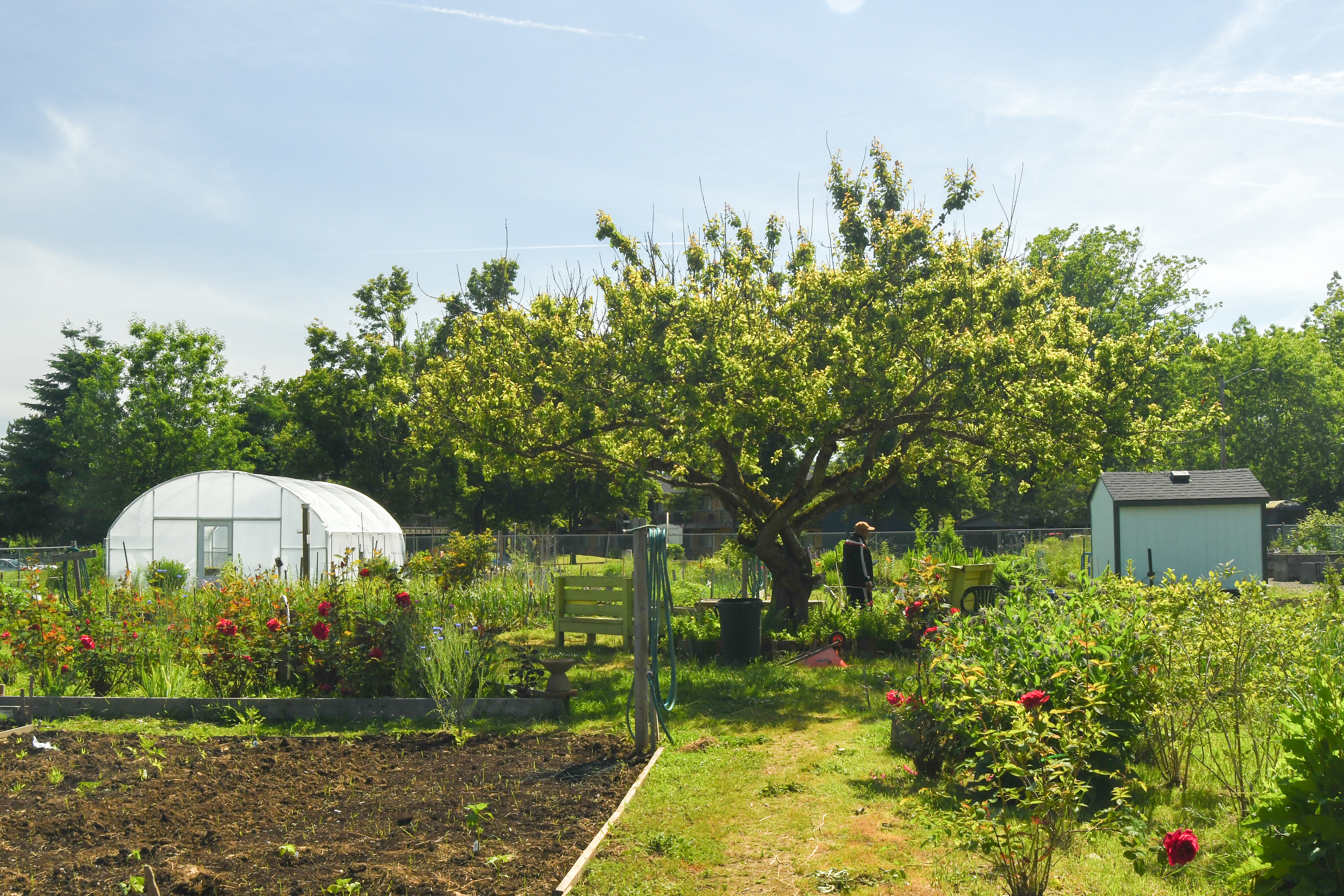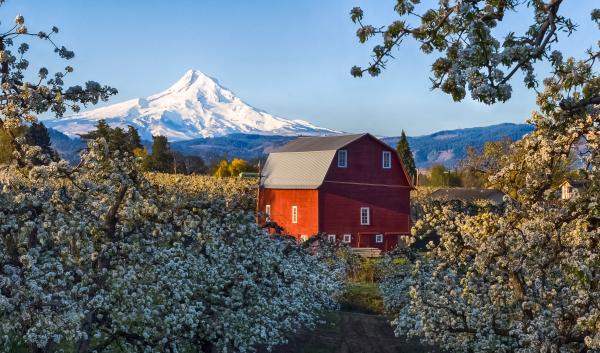Reading time: 7 minutes

In the Northwest, climate change poses challenges to agricultural production, food systems, and rural communities. Rising temperatures, changing rain and snow patterns, and increasing instances of extreme events are leading to increasingly severe droughts, heatwaves, floods, and erosion. These changes can affect the types of crops that can grow well, the availability of irrigation water, and the health of crops and livestock, with economic and well-being implications for farmers and ranchers in the region.
To add to the complexity, agriculture is not only affected by climate change, but also contributes to climate change through the release of greenhouse gases. Agricultural operations, including fertilization with nitrogen and tillage, can emit greenhouse gasses, as can livestock production and the transportation of produce. In 2022, direct emissions from the agriculture sector accounted for 9.4% of total U.S. greenhouse gas emissions. As such, it is important for producers to use practices that can help to offset agricultural emissions and increase the adaptability of crops and livestock to climate change. Agroforestry – integrating trees and shrubs with agriculture – includes practices that can help farmers, ranchers, and communities increase their adaptability to extreme events, while providing an opportunity to mitigate agricultural emissions by increasing carbon storage on agricultural land.
Agroforestry practices in Idaho, Oregon, Washington, and Alaska
Agroforestry has a long history in Idaho, Oregon, and Washington. Indigenous communities have employed these practices for millennia, and some of those traditions continue today. Though very little agroforestry has occurred in Alaska to date, there is potential for growth as the climate continues to warm.
Recently, agroforestry has gained renewed interest because of its potential to store carbon and provide other environmental benefits. Agroforestry practices are as diverse as Northwest landscapes, and vary according to climate, soils, topography, and other factors. Despite this variety, there are a number of common agroforestry practices in the region:
Silvopasture integrates trees, forage crops, and livestock on a single plot. Trees can provide shade and shelter for livestock and forage, which can reduce stress caused by heat, heavy precipitation, or other harsh weather conditions. If timber trees, orchard trees, or other kinds of harvestable tree crops are integrated in silvopasture systems, farmers can generate additional economic benefits.

Alley cropping is planting rows of crops between rows of trees or shrubs. It can provide multiple benefits for crops, including shade to regulate temperature for crops that prefer less sun, wind protection, nutrient cycling, erosion prevention, and depending on the species of tree, nitrogen fixation to enrich the soil.
Forest farming uses the canopy of a stand of trees or managed forest to grow various products. By carefully managing shade levels, farmers can grow high-value crops like mushrooms, floral greenery, and juniper berries beneath and on existing trees.
Windbreaks are rows of trees or shrubs planted around fields to create wind barriers. Windbreaks can shelter crops, animals, buildings, and soil from wind, snow, and dust. These areas can also support wildlife and provide another source of income if harvestable species are planted (e.g., hazelnut, chokecherry) and habitat is suitable.
Riparian buffers, natural or restored areas along rivers and streams around a farm, are composed of trees, shrubs, grasses, and forbs. These buffers act as filters for farm runoff and pollutants. Their root systems can stabilize the banks of waterways, preventing erosion. Riparian buffers can also provide habitat for wildlife. These zones are used to improve water quality, create healthy fish habitat (particularly for salmon and steelhead in the Northwest), and control erosion.
Forest gardens, also known as food forests, consist of multiple layers of perennial and annual vegetation, including trees, shrubs, vines, herbaceous crops, root crops, groundcover crops, and more. Forest gardens can be found in communities, backyards, and farms throughout the Northwest. Trees in food forests might produce nuts or fruit and offer shade for other plants, such as mushrooms, herbs, and berries. When implemented in urban areas, food forests can improve urban air quality, help to manage stormwater, increase community food security, and provide a number of other benefits.
Agroforestry can be applied on farms and in gardens, urban areas, forests, and more. Because most agroforestry practices use less than 5% of a field area, they can be incorporated into farms of most sizes. There are also specialized applications of agroforestry, including those used to produce biofuels and provide pollinator habitat. Agroforestry practices can be varied and combined in many ways. For example, an agroforestry system might involve a simple setup of a few rows of planted trees within a field of crops. On the other hand, a system can be complex, such as a layered food forest with many levels of vegetation. The specific design of an agroforestry system depends on the goals of the landowner.
Benefits of agroforestry for climate change adaptation and mitigation
Landowners adopt agroforestry practices for a variety of reasons. Some want to diversify their operations with different crops. Others want to provide shade for livestock, reduce farm emissions, or restore healthy waterways for salmon or steelhead populations. No matter the specific goals of the landowner, agroforestry can help to increase the climate adaptability and mitigation potential of farms. Some of the benefits of agroforestry include:

Greenhouse gas mitigation. Trees in agroforestry systems store carbon in their trunks and branches, and healthy soils enriched by tree roots can also store carbon. This carbon storage potential makes agroforestry a powerful tool for climate change mitigation. Agroforestry practices can sometimes decrease fuel needs by requiring less tilling and field work and cutting back on equipment use. Trees can also provide wind protection and shade, reducing the need to cool or heat buildings, depending on the season.
Enhanced adaptability. Integrating trees and shrubs into agricultural landscapes can increase soil organic matter, support soil biology, improve soil structure, and increase soil water holding capacity. Improved soil health can help crops build resilience to drought and heat stress. Tree shade can also reduce heat stress in crops and livestock in warmer months and climates.
Erosion control. Strategic planting of trees and shrubs in alley cropping systems or as windbreaks can help to reduce soil erosion. Riparian buffers can also stabilize streambanks and minimize runoff and erosion caused by heavy rains, and in some cases, floods.
Water quality and availability. Agroforestry practices can filter runoff from farm fields, reducing fertilizer and pesticide runoff that could affect water quality and harm aquatic species. Windbreaks and silvopasture can also help reduce the water needs of crops and livestock by providing shade and reducing temperatures. Riparian buffers, if implemented in very specific designs, can sometimes lessen the impact of floods and stream channel erosion by regulating stream discharge and peak stormflows. Finally, by providing shade to streams, agroforestry can help regulate water temperature, maintaining a cooler environment for aquatic species.
Habitat and biodiversity. Trees and shrubs can provide valuable habitat for pollinators, beneficial insects, birds, and other wildlife. Expanded wildlife habitat promotes biodiversity, which can improve overall ecosystem health and pest control.
Enhanced food security. Agroforestry systems that are in communities and open to the public can increase access to fresh, local food, and provide a range of environmental benefits. In urban areas, these systems can improve air quality, cool temperatures in cities, collect stormwater, and improve wildlife habitat. Urban food forests exist in several communities in Idaho, Oregon, and Washington.
Challenges and considerations for implementing agroforestry

Though there are many benefits to agroforestry practices, there can be challenges associated with implementing these practices in the Northwest. Climate change itself presents obstacles to growing trees, shrubs, and crops and raising livestock, especially in areas with hotter, drier summers and more frequent extreme weather events. Because the design of agroforestry systems varies widely and is dependent on a number of climate- and topography-related factors, designing systems that meet landowner goals in locations throughout the Northwest can be a challenge. For instance, riparian forest buffers will probably not have the same species or configuration in southern Idaho as they do in western Oregon, because each place has a different combination of soils, hydrology, and climate that suits different arrangements. This can make it more difficult for regional farmers to share successful practices and strategies with one another.
Some other common barriers to the implementation of agroforestry practices include high initial investment costs, lack of access to technical information and assistance, challenges with planning and managing a long-term practice, and perceptions of economic risk and uncertainty.
One of the key concepts of agroforestry is putting the right tree in the right place for the right purpose. Landowners should be familiar with their farm or field’s climate, soils, topography, and hydrology, and should also understand their equipment needs, local markets, and what trees or crops might work on their farm. To add to the decision-making challenges, not all agroforestry practices act as natural climate solutions. As such, agroforestry implementation for climate adaptation or mitigation requires careful design. Decision-support tools, conservation programs, and other agroforestry resources designed for landowners are available to help in this process.
A bright future for agroforestry in the Northwest
Despite challenges, the potential benefits of agroforestry for agriculture are significant. By integrating trees and shrubs into agricultural landscapes, landowners can adapt to a changing climate, improve the sustainability of their operations, reduce their carbon footprint, and contribute to biodiversity and ecosystem health. As research and knowledge-sharing between farmers and organizations continue to expand, agroforestry adoption is poised to increase throughout the region, with the potential to create a more resilient agricultural future for landowners and their communities.
Snohomish Conservation District Examples
Pacific Northwest Tribal Agroforestry – this StoryMap shares ideas and examples of how tribal land, resource stewardship, and agroforestry practices relate to one another in the Northwest.
Moscow, Idaho’s Edible Forest – this future 4-acre food forest will include fruit and nut bearing trees, shrubs, and edible plants.
Beacon Food Forest – this food forest in the Beacon Hill neighborhood of Seattle provides fresh produce, pollinator habitat, healthy soils, climate change mitigation, storm water filtration, educational opportunities, and community space.
Agroforestry Efforts in the Pacific Northwest – this webpage from Agroforestry Northwest includes links to several agroforestry projects in the region.
NRCS Conservation Practice Standards for Agroforestry – Silvopasture, alley cropping, forest farming, riparian buffers, and windbreaks are explicitly included in the NRCS Conservation Practice Standards for conservation planning in Idaho, Oregon, and Washington. In Alaska, alley cropping, riparian buffers, and windbreaks are included.
NRCS Financial Assistance is directly tied to these Standards, and is delivered through programs such as the Environmental Quality Incentives Program (EQIP), the Conservation Stewardship Program (CSP), and other USDA and state conservation programs.
COMET-Farm is a tool that enables a user to describe agroforestry practices according to the number of trees in their system and the sizes (diameters) of those trees; from this information, the tool calculates the biomass carbon stock now and at 10-year intervals for 50 years in the future.
National Agroforestry Center Tools Page provides design and planning tools, economic tools, and learning and networking tools for landowners interested in agroforestry.
Wet Feet Farming: A farmers’ guide to integrating agroforestry into wet areas is a draft guide that discusses the application of agroforestry practices to wet, marginal farmland to increase production, specifically in the Northwest.
Design and Application of Silvopasture in Washington State is a research paper that investigates the livestock, forages, and tree composition of existing silvopasture systems, as well as landowner goals for these systems in Washington.
-
Agriculture in the Northwest
A summary of agriculture in Idaho, Oregon, and Washington and the effects of climate change on Northwest agriculture.
-
Agrivoltaics: Pairing Solar Power and Agriculture in the…
Agrivoltaics – the pairing of solar power generation with agriculture – could improve climate adaptability in the Northwest.
-
Management Actions for Northwest Agriculture
A suite of management actions that can assist agricultural producers in Alaska, Idaho, Oregon, and Washington adjust their operation to mitigate and adapt to…




